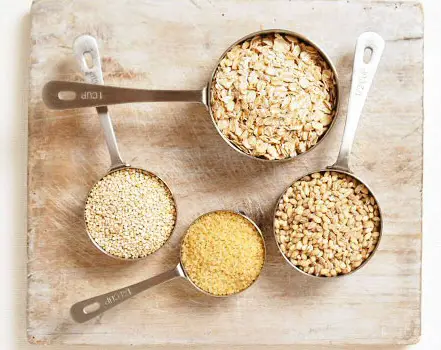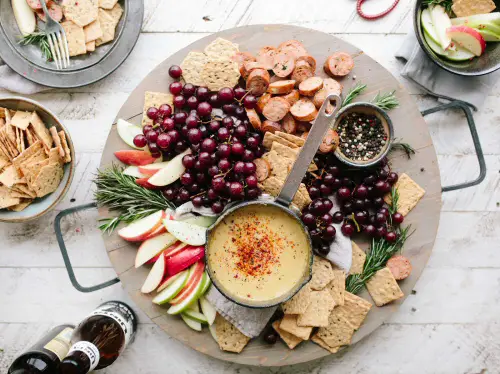What is gluten?
Gluten is the protein component found in wheat, rye and barley. People often think oats contain gluten but they actually contain avenin, which is a protein similar to gluten. Research has shown many people who avoid gluten can safely eat avenin, however, problems can arise if oats are handled in the same place as wheat, barley or rye, as the oats can become contaminated by these other grains.
Gluten Sensitivity vs. Celiac Disease
 A gluten sensitivity is different to a true gluten allergy, which is also known as celiac disease. If you’re sensitive to gluten you may experience symptoms similar to irritable bowel syndrome (IBS) such as brain fog, gas, diarrhea, and constipation as well as certain skin conditions such as rashes when eating gluten containing foods. Since food sensitivities often produce delayed reactions rather than sudden immune responses, signs of gluten sensitivity can take as long as 36 hours to show up.
Unlike a food sensitivity, those with celiac disease will have a full-blown immune reaction when they come in contact with gluten. This can result in sudden cramping and diarrhea, several days of severe digestive symptoms, vomiting, fatigue, irritability and over time, extreme weight loss. The Celiac Disease Foundation estimates that every 1 in 100 people have celiac disease, and most aren’t diagnosed.
A gluten sensitivity is different to a true gluten allergy, which is also known as celiac disease. If you’re sensitive to gluten you may experience symptoms similar to irritable bowel syndrome (IBS) such as brain fog, gas, diarrhea, and constipation as well as certain skin conditions such as rashes when eating gluten containing foods. Since food sensitivities often produce delayed reactions rather than sudden immune responses, signs of gluten sensitivity can take as long as 36 hours to show up.
Unlike a food sensitivity, those with celiac disease will have a full-blown immune reaction when they come in contact with gluten. This can result in sudden cramping and diarrhea, several days of severe digestive symptoms, vomiting, fatigue, irritability and over time, extreme weight loss. The Celiac Disease Foundation estimates that every 1 in 100 people have celiac disease, and most aren’t diagnosed.
Gluten-free diets
A strict gluten-free diet involves the avoidance of any product made from wheat, barley or rye, so check all the labels carefully.
Avoiding gluten can be hard as wheat is so widely used in commercially manufactured, ready-made foods. But eating gluten-free doesn’t have to mean brick-like-bread, dry flaky pastries or gritty gluten-free crackers, nor does it mean sacrificing good nutrition and tasty food. Fortunately there are now a wide range of gluten-free products and resources available. Becoming informed and able to read labels and ingredient lists to recognise gluten in its many guises will certainly be an advantage. The Coeliac UK website has a trusted food and drink directory for members along with other useful advice on living gluten-free. They also have a mobile app complete with barcode scanner, label guide and eating out tips.
If you are following a gluten-free diet, try to ensure it is nutrient dense and full of whole foods. Although there are a wide range of gluten-free products now available, they may not be as high in fibre, iron, folic acid and B vitamins as gluten containing counterparts. If you have any queries concerning your nutritional intake you should speak to your GP.
To ensure you are getting enough fibre and B-vitamins, eat a wide variety of gluten-free grains, fruit and vegetables. Alternative grains such as corn (maize, polenta), soya, potato, quinoa, cornflour, millet, arrowroot, buckwheat, amaranth and rice flours can increase the nutrient profile of the gluten-free diet. Opt for whole grain gluten-free flour mixes which contain more fibre than the highly refined tapioca, white rice and corn starch flours.
The best sources of iron are from meat such as beef, poultry and fish or plant based sources such as beans, legumes and leafy green vegetables, which are all naturally gluten-free. To enhance the absorption of iron, consume iron rich foods with sources of vitamin C.
Folic acid has particular importance for pregnant women and women in their child-bearing years. Some of the best sources are yeast, green leafy vegetables, asparagus, broccoli, cauliflower, beans and lentils.
Things to watch out for
 ‘Hidden’ gluten may be in processed meats, dry roasted nuts, marinades, soy sauce, condiments, malt, spice mixes and more. It is advisable to read the labels on everything you plan to eat and create a ‘safe’ foods list
‘Hidden’ gluten may be in processed meats, dry roasted nuts, marinades, soy sauce, condiments, malt, spice mixes and more. It is advisable to read the labels on everything you plan to eat and create a ‘safe’ foods list
Oats: Some people with coeliac disease can eat oats but they are often produced in the same place as wheat, barley and rye and may be at risk of cross contamination. If you do eat oats, choose those labelled ‘gluten-free’.
Labelling: ‘Gluten Free’ food labels = There is now a law covering the use of ‘gluten-free’. When you see this label it must contain no more than 20 parts per million of gluten.
Cost: Gluten-free diets can be quite expensive. In some parts of the UK, people with coeliac disease are eligible for foods on prescription – check with your GP.
Gluten-free flours are not as easy to bake with as they lack the elastic properties of gluten. As a result breads may rise (due to yeast or raising agents) but fall again to leave rather dense loaves. Xanthan gum is a natural powder, which if added in small quantities to flour for bread and pastry making, makes a reasonable substitute for the elastic characteristics of gluten.
Combination flours work best for cakes, biscuits and pastry: 60% stronger flours (such as gram or maize) to 40% finer, lighter flours (such as white rice, potato or tapioca). Corn bread made from ground corn or maize meal (NOT cornflour) is a delicious gluten-free bread substitute.
What Can You Eat on a Gluten Free Diet?
 A gluten-free diet may sound restrictive, but it really just comes down to eating fewer processed foods and grains and focusing on whole foods like fruits, vegetables, healthy fats, and lean protein— which is the best way to support your overall health anyways.
A gluten-free diet may sound restrictive, but it really just comes down to eating fewer processed foods and grains and focusing on whole foods like fruits, vegetables, healthy fats, and lean protein— which is the best way to support your overall health anyways.
Gluten Free Grains: brown rice, buckwheat, jasmine rice, quinoa, teff, amaranth, wild rice, and nut flour such as coconut and almond flour
Condiments: coconut aminos (an excellent low sodium substitute for soy sauce), most varieties of regular mustard and Dijon mustard, most natural brands of ketchup are gluten-free
Sweeteners: raw honey, pure maple syrup, green leaf stevia, coconut sugar, date sugar
Since gluten hides in most processed, boxed, and packaged foods, it’s easiest to follow a gluten-free diet when you prepare your meals at home where you can control exactly which condiments, sweeteners, and grains go into your meals (this is important for avoiding cross-contamination too, if you do have celiac disease).
And let’s not forget: gluten-free isn’t just a buzzword anymore. With the increasing sensitivities, many restaurants and grocery stores have gluten-free options available.
Final Note: Although many packaged and pre-prepared foods have a gluten-free label, keep in mind that gluten-free doesn’t always mean “healthy.” Most processed foods still contain high amounts of refined sugar, food additives, and preservatives.